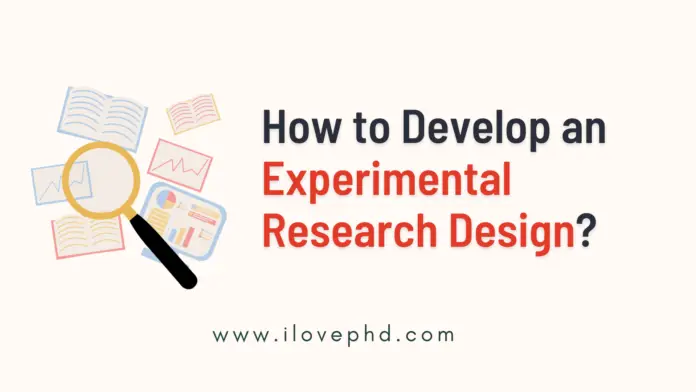Experimental research is an essential foundation of scientific inquiry, allowing researchers to establish causal relationships between variables. Whether you’re a student working on a class project or a seasoned scientist conducting ground-breaking research, developing a robust experimental research design is essential. In this article, iLovePhD takes you through the key steps to create a well-structured experimental research design.
How to Develop an Experimental Research Design: A Step-by-Step Guide
Step 1: Define Your Research Question
The first step in developing an experimental research design is to clearly define your research question or hypothesis.
What specific topic or problem are you trying to investigate? Your research question should be focused, specific, and capable of being tested experimentally. A detailed post on “How to develop research question?” is discussed in iLovePhD.
Step 2: Identify Variables
Once you have your research question, you need to identify the variables involved. Variables are the elements you will manipulate and measure in your experiment. There are two main types of variables:
a. Independent Variable (IV): This is the variable you manipulate to see its effect on the dependent variable. It is often referred to as the cause.
b. Dependent Variable (DV): This is the variable you measure to observe the outcome or effect of the independent variable. It is often referred to as the effect.
Also Read: Types of Research Variable in Research with Example
Step 3: Formulate Hypotheses
Based on your research question and identified variables, you should formulate one or more hypotheses. These are educated guesses about the expected outcomes of your experiment. There are two types of hypotheses:
a. Null Hypothesis (H0): This states that there is no significant effect or relationship between the variables being studied.
b. Alternative Hypothesis (H1): This is the opposite of the null hypothesis and suggests a significant effect or relationship between the variables.
Also Read: What is Hypothesis in Research?
Step 4: Choose Your Experimental Design
Selecting the right experimental design is crucial to the success of your research. Common experimental methods include:
a. Pretest-Posttest Control Group Design
b. Posttest-Only Control Group Design
c. Solomon Four-Group Design
d. Within-Subjects Design
e. Between-Subjects Design
Choose the design that best suits your research question and resources. Ensure that it allows you to manipulate the independent variable(s) and measure the dependent variable(s) effectively.
Also Read: What is a Research Design? Importance and Types
Step 5: Define Your Experimental Group and Control Group
In experimental research, it’s essential to have both an experimental group and a control group. The experimental group receives the treatment or manipulation, while the control group does not. This helps you compare the effects of the independent variable against a baseline.
Step 6: Develop a Research Protocol
Create a detailed research protocol outlining the step-by-step procedures of your experiment. Include information about how you will manipulate the independent variable, measure the dependent variable, and any control measures in place to ensure the validity of your results.
Step 7: Collect Data
Follow your research protocol carefully to collect data from both the experimental and control groups. Ensure that the data collection process is consistent and unbiased to maintain the integrity of your results.
Also Read: How to Conduct a Research Survey: A Step-by-Step Guide
Step 8: Analyze Data
Once you have collected your data, use appropriate statistical techniques to analyze it. This will help you determine if there is a significant effect or relationship between the variables. Common statistical tests include t-tests, ANOVA, and regression analysis.
Also Read: 5 Free Data Analysis and Graph Plotting Software for Thesis
Step 9: Interpret Results
After analyzing the data, interpret your findings in the context of your research question and hypotheses. Discuss whether the results support or reject the null hypothesis and provide insights into the implications of your findings.
Step 10: Report Your Research
Finally, communicate your research findings through a well-structured research paper or report. Include all relevant details, such as the research question, methodology, results, and conclusions. Properly cite your sources and follow the formatting guidelines of your chosen publication outlet.
Conclusion – Experimental Research Design
Developing an experimental research design is a systematic process that requires careful planning and execution. By following these ten steps, you can create a robust experimental design that allows you to investigate your research question, establish causality, and contribute to the body of scientific knowledge.
Experimentation is at the heart of scientific discovery, and a well-designed experiment is the key to obtaining reliable and meaningful results.
Indexed Journal – Your Journal Search Ends Here
Check Journals List -> Indexed Journal
Search Scopus Journals-> Scopus Finder


